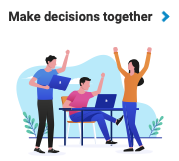4 Key Features of DiSC Catalyst Your Groups Learning Module
 Everything DiSC® Catalyst™ is an engaging learning platform that provides access to Everything DiSC assessment feedback, comparisons of DiSC Styles between teammates, opportunities to create unlimited team maps, and additional DiSC concepts, videos and research not provided in DiSC results reports.
Everything DiSC® Catalyst™ is an engaging learning platform that provides access to Everything DiSC assessment feedback, comparisons of DiSC Styles between teammates, opportunities to create unlimited team maps, and additional DiSC concepts, videos and research not provided in DiSC results reports.
Organizations that have adopted Catalyst have found significant increases in DiSC applications, on-going engagement, and continual learning. Team members regularly access Catalyst to learn how to build bridges of understanding with teammates and across their team(s) using both the Your Groups and My Colleagues Catalyst Learning Modules.
What is the DiSC Catalyst ‘Your Groups’ Learning Module?
A picture is worth a thousand words! Team maps within the Catalyst ‘Your Groups’ learning module provides a gateway to understanding team dynamics across unlimited teams. Facilitators, team leaders, or project teams can create a team map(s). Once a map is created, all members of the team will have immediate access to the team map. As Catalyst learners engage with different teams and team members, the Your Groups module keeps team maps up to date and relevant.
What are the Key Features of the Catalyst ‘Your Groups’ Module?
Your Groups offers four areas of feedback that help teams increase and leverage collaboration and communication efficiencies. Catalyst Your Groups keeps DiSC front and center with continued applications that drive team  performance.
performance.
#1) Group Maps: Create unlimited team maps. Quickly identify the distribution of DiSC styles across your team. Identify areas of strength and opportunity areas. Easy to administrate, team maps can be created by team leaders, managers, DiSC facilitators, project leads, etc. Once a map has been created, all team members within that map will see the team map on their personal Catalyst learning platform.
 #2) DiSC Style Insights: Quickly identify team members within each DiSC style and learn valuable information on what drives and motivates each DiSC style.
#2) DiSC Style Insights: Quickly identify team members within each DiSC style and learn valuable information on what drives and motivates each DiSC style.
#3) Group/Team Insights: Learn the percentage breakdown of DiSC styles within your team. Gain insight into team distributions across eight behavioral tendencies. These provide a deeper dive into team member preferences and team members show up to work. Teams are able to engage in meaningful dialogue to explore how team results impact both 1:1 and team communications. This insight provides valuable data to help team members increase understanding and emotional awareness.

#4) Conversation Starters: Dive deeper into DiSC with conversation topics that create a foundation of understanding, respect and productive collaboration. Three specific topics take teams on a journey of discovery.
 TOPIC #1: Get to Know Your Team
TOPIC #1: Get to Know Your Team
Team members explore two behaviors that impact how individuals go about their work day. Do they prefer a fast-paced environment or a slower, steady pace? If too many on the team prefer a fast pace, this might result in too little attention to details and/or taking risks without calculating potential consequences.
CASE: Working with an executive team of a client in the digital customer engagement industry, the pace was relentless. People were working non-stop while managing constant shifts in priorities. The company was meeting their financial projections but unknown to the CEO at the time, half the executives were burned out and unhappy with a third of them having their foot out the door. In fact, before we were able to have our first session with the team, two individuals quit. The CEO was so focused on numbers and chasing the next idea that he forgot to take care of his people. Once the CEO and his team saw their unbalanced DiSC team map, they had a major a-ha moment that drove a much needed conversation to start rebuilding trust within the team.
Likewise, let’s look at the balance between team members who prefer working independently versus those that get their energy by working with others. Both sides can get annoyed and frustrated with the other. Great team players are those that have the emotional awareness of how to balance preferences across DiSC styles.
CASE: A senior manager in a large organization was having difficulty with her team. She perceived the team as having low morale. After conducting 1:1’s with each team member, it became very obvious why there was low morale. The direct reports had DiSC preferences for collaboration and valued meeting as a team. Their senior manager was perfectly happy working on her own and disregarded the importance of team engagement. Once both sides understood this key difference, they were able to increase their social awareness and work on strategies to accommodate the differences in DiSC preferences.
 TOPIC #2: Make Decisions Together
TOPIC #2: Make Decisions Together
Making decisions together can be challenged when some of the team are strong-willed while others are more accommodating. Often there are team members who tend to control the meeting or conversation. It can be challenging getting a word in for others. Building awareness of the different DiSC preferences across the team is critical to ensure that all team members are being heard.
When problem-solving towards a decision, some team members are more skeptical and may need to be convinced. Others are more accepting and might give the benefit of the doubt even to avoid conflict. The left and right sides of the DiSC model illustrates the balance between these two preferences and provides realization of how the team is distributed across the team map.
TOPIC #3: Communicate Clearly
Our style of communication can impact how others perceive us. Some team members are tactful, taking time to consider how to respond, while others are more frank, speaking quickly and bluntly. Understanding the team distribution across this continua can help team members to better understand how to engage with others more thoughtfully. Many individuals may be unaware of how their communication preference comes across to others.
How a team member prefers to engage in a discussion can fall between those that are more structured versus unstructured approach. The structured preference likes conversations to be focused with clear goals and a systematic data driven process. The unstructured style welcomes new ideas and values divergent thinking. It can be a challenge and often times is the source of conflict.
How to Put Catalyst ‘Your Groups’ into Practice
The Catalyst Your Groups learning module is an engaging and collaborative way to keep DiSC moving forward in the organization. Include it as part of a DiSC Facilitated experience or kick off meetings with a DiSC Conversation Starter. Applying DiSC reinforces principles and helps individuals and teams to increase both personal and social awareness. These skills are critical to manage team efficiencies and drive higher performance.
Learn How to Bring DiSC Catalyst to Your Team


